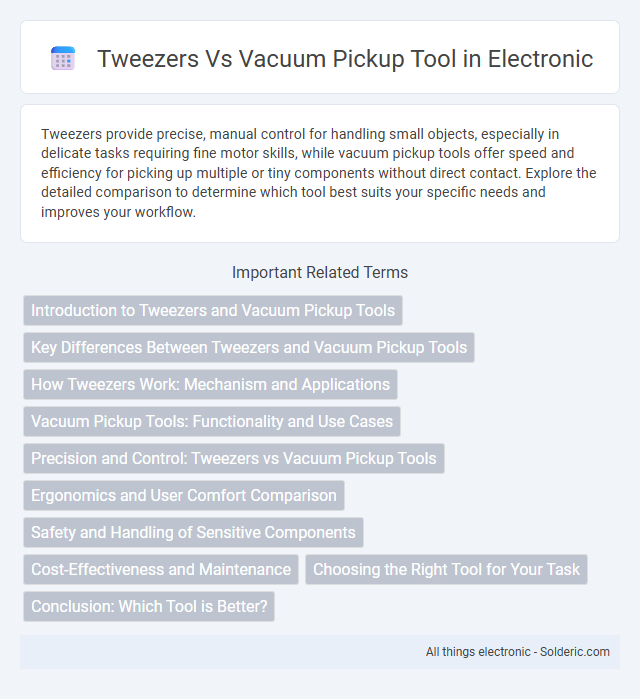Tweezers provide precise, manual control for handling small objects, especially in delicate tasks requiring fine motor skills, while vacuum pickup tools offer speed and efficiency for picking up multiple or tiny components without direct contact. Explore the detailed comparison to determine which tool best suits your specific needs and improves your workflow.
Comparison Table
| Feature | Tweezers | Vacuum Pickup Tool |
|---|---|---|
| Primary Use | Manual gripping and positioning of small components | Non-contact pickup of small, delicate parts using suction |
| Precision | High precision for controlled handling | Moderate precision dependent on vacuum strength and nozzle size |
| Suitable Materials | Solid small parts, static components | Fragile, smooth-surfaced parts |
| Damage Risk | Potential mechanical damage due to direct contact and pressure | Minimal mechanical stress, reduced risk of surface damage |
| Ease of Use | Simple, requires steady hand and skill | Requires vacuum source and setup, easier for repetitive tasks |
| Application Areas | Electronics assembly, laboratory work, crafting | Electronics pick-and-place, semiconductor handling, microassembly |
| Cost | Low cost, minimal maintenance | Higher initial cost, requires maintenance of vacuum system |
Introduction to Tweezers and Vacuum Pickup Tools
Tweezers provide precise manual control for handling small components during assembly or repair tasks, ideal for accurate placement and manipulation. Vacuum pickup tools utilize suction to securely lift and move delicate or tiny parts without direct contact, reducing the risk of damage or contamination. Both tools are essential in electronics manufacturing, laboratory work, and delicate mechanical projects, offering complementary solutions based on the size and sensitivity of the components involved.
Key Differences Between Tweezers and Vacuum Pickup Tools
Tweezers provide precise manual control for handling small components through direct gripping, ideal for delicate or intricate tasks in electronics and jewelry. Vacuum pickup tools use suction to lift and place items without physical contact, reducing the risk of contamination or damage, and are preferred for cleanroom environments or handling sensitive materials. The key differences lie in the gripping mechanism--mechanical versus pneumatic--and their suitability for varying precision, speed, and cleanliness requirements.
How Tweezers Work: Mechanism and Applications
Tweezers operate using a simple spring mechanism that allows precise gripping and manipulation of small objects through opposing tips made of metal or plastic. Their applications span across electronics assembly, medical procedures, and beauty care, providing controlled handling of delicate components or tissues. By applying targeted pressure, tweezers enable detailed work where accuracy and stability are crucial.
Vacuum Pickup Tools: Functionality and Use Cases
Vacuum pickup tools use suction to securely grasp small, delicate objects, making them ideal for handling electronics, glass components, or tiny mechanical parts without causing damage. Their adjustable vacuum pressure ensures precise control during component placement or removal, enhancing accuracy in assembly or repair tasks. You benefit from improved efficiency and reduced risk of contamination compared to traditional tweezers, especially in cleanroom or high-precision environments.
Precision and Control: Tweezers vs Vacuum Pickup Tools
Tweezers provide superior tactile feedback and fine control ideal for handling small components with precision, making them essential in delicate electronic assembly and laboratory tasks. Vacuum pickup tools offer consistent suction and are effective for quickly picking and placing flat or smooth-surfaced items, though they may lack the nuanced control required for intricate adjustments. Choosing between tweezers and vacuum pickup tools depends on the specific application's need for exact manipulation versus speed and repeatability.
Ergonomics and User Comfort Comparison
Tweezers offer precise control and tactile feedback, making them ideal for delicate tasks but can cause hand fatigue during prolonged use due to their pinching motion. Vacuum pickup tools reduce strain on fingers by using suction to lift components, promoting ergonomic comfort, especially in repetitive tasks or handling small parts. Choosing the right tool depends on your need for precision versus sustained comfort, with vacuum tools generally favoring ergonomics for extended use.
Safety and Handling of Sensitive Components
Vacuum pickup tools offer superior safety for handling sensitive components by minimizing direct contact, reducing the risk of electrostatic discharge and mechanical damage. Tweezers require precise control and anti-static properties to avoid component distortion or contamination during manual handling. Selecting the appropriate tool depends on the component's fragility and the need for contamination-free assembly in electronics manufacturing.
Cost-Effectiveness and Maintenance
Tweezers are highly cost-effective with minimal upfront investment and virtually no maintenance, making them ideal for simple, precise tasks. Vacuum pickup tools require a higher initial cost and periodic maintenance like filter replacement and suction calibration but offer faster handling for delicate or small components. Your choice depends on balancing budget constraints with the frequency and complexity of your application.
Choosing the Right Tool for Your Task
Selecting the right tool depends on the precision and nature of the task; tweezers offer fine control for handling small, delicate components in electronics or crafts, while vacuum pickup tools excel at quickly and cleanly lifting flat or smooth objects without damage. Tweezers are ideal for tasks requiring tactile feedback and intricate manipulation, especially in tight spaces or for irregularly shaped items. Vacuum pickup tools enhance efficiency in repetitive pick-and-place operations, minimizing manual strain and reducing contamination risk in cleanroom environments.
Conclusion: Which Tool is Better?
Tweezers provide precise control and are ideal for delicate tasks requiring fine detail, while vacuum pickup tools offer speed and efficiency for handling small components in large quantities. The choice depends on the application: for detailed electronics assembly, tweezers enhance accuracy, whereas vacuum tools excel in high-volume manufacturing settings. Evaluating specific project needs and component sensitivity determines which tool is better suited.
Tweezers vs vacuum pickup tool Infographic

 solderic.com
solderic.com